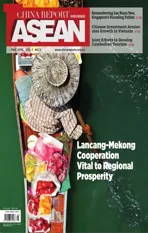Weifang Kites Fly Higher in New Artistic Era
2016-09-26ByWangFengjuan
By Wang Fengjuan
Weifang Kites Fly Higher in New Artistic Era
By Wang Fengjuan

Han Fuling, 84, explaining to young visitors the techniques of making and flying a kite
han Fuling, 84, has shown his homemade kites at the Weifang International Kite Festival each April since 1984. During this year’s festival, in celebration of the year of the monkey, he crafted a hard wing kite in the shape of a golden monkey.
In Weifang, a city of nine million in China’s Eastern Shandong Province, there are many who share a passion for kites. the city’s kite festival attracts participants from all around the world and has become an important part of Weifang’s image on the international stage.
Dragon Head Kite a Hit in Singapore
Han, who craths large, elaborate kites, is best known for his dragon head centipede, a 120-meter-long behemoth that features 240 joints. He took his centipede to Singapore’s international kite festival in 1985, attracting great attention. Han looks back to his first experience taking a kite abroad with great athection.
He recalls that many Chinese-Singaporeans applauded and cheered when he and his team, wearing costumes with the word China printed on them, carried the huge kite onto the stage. The crowd roared when their kite gained altitude, Han said.
“Everybody was excited. Many in the audience threw their hats into the air,” he said.“What a beautiful scene. I was overwhelmed with joy.”
Afterwards, the Singapore Chinese language newspaper Lianhe Zaobao interviewedhim and published a picture of the kite, further adding to Han’s fame in Singapore.
Han took his kite to Italy in 1990. The international kite festival was held in Urbino in the country’s southwest, the hometown of famous painter Raphael Sanzio (1483-1520),on the same day when the football World Cup kicked off in Milan. Han’s dragon and phoenix shaped kites won the competition’s gold medal.
Weifang’s Cultural Genes
The annual Weifang International Kite Festival and the China Weifang Culture & Art Fair held each April have done much to improve Weifang’s reputation as a historical and cultural city. The city has been dubbed the “Chinese Painting Metropolis” and the“World Kite Metropolis”, which has provided great impetus to the city’s upgrading and transformation.
The city boasts a long history of Chinese folk arts and crafts. Along with Suzhou in Southern Jiangsu Province, Weifang is known as one of China’s most significant folk culture cities, where more than 1,800 cultural relics, historical sites, buildings and stone inscriptions remain. Weifang kites date back more than 2,000 years. Woodcut New Year pictures, which are also a famous part of Weifang’s cultural heritage, are thought to have started around 1,000 years ago. Nourished by profound cultural elements and a clean environment, the local cultural industry is showing great vitality.
With the development of the cultural industry, Weifang’s Nandaying, a block near the city center, was transformed from an old Russian-style warehouse into the Nandaying 1789 Cultural District, an art community with modern infrastructure.
The cultural district retains 13.34 hectares of the original industrial warehouses and workshops, divided into four sections: traditional culture, modern creativity, railway culture and tea culture. Today, the art district is home to 40 enterprises including pottery,woodcarving, painting, calligraphy, etc.
Culture & Art Fair
The Ninth China Weifang Culture & Art Fair kicked oth at the Shandong-Taiwan Convention & Exhibition Center on the morning of April 17.
A group sculpture crafted by Fu Shaoxiang, renowned as a master of industrial art, and pottery master Cai Jie was a particularly eye-catching feature at the fair. Sponsored by the Shandong Huayi Diaosu Company and blending traditional pottery and sculpting techniques, the sculpture integrates the ancient Silk Road with the modern Belt and Road Initiative to produce a classical work representing the trade bridge linking Asia and Europe, as well as the cultural bonds between the East and West.
The “Maritime Silk Road” section of the fair depicted prosperous environments from more than 2,000 years ago, blending elements of the vast ocean, grand fleets, Chinese tea,silk and pottery, as well as bustling markets.the “Land Silk Road” section revealed a harmonious environment of cooperation, peace and development featuring people from all around the world.
“It gives a vivid image of the whole Silk Road,” said Guo Meng, a visitor to the fair from Beijing. “It must have taken a lot of ethort from many people.” the sculpture was particularly popular among visitors taking photographs.
Covering 40,000 square meters, the fair featured an unprecedented level of rich and diverse cultural contents including Chinese oil painting landscape works, literary and creative works, Taiwanese cultural artifacts and various other works of art and design. The China Folk Art Exposition section featured more than 100 artists from all across the country, including exquisite works of pottery, purple clay, rosewood, embroidery,clay sculpture and bamboo weaving in 50 categories. At the pottery exhibition area,artists showed visitors how to crath porcelain and polychrome painting on the spot.
In recent years, the Weifang Government has done much to boost local artwork and cultural items, including the hosting of fairs and the construction of the Nandaying 1789 Cultural District.
Liu Shuguang, Deputy Secretary of the CPC WeiFang Municipal Committee and Mayor of Weifang, views celebrating Weifang’s artistic history as a key part of the city’s path to development.
“For common cultural prosperity, it is our sincere hope that the China Weifang Culture & Art Fair will promote friendship,deepen exchanges and enhance cooperation with artists and cultural institutions at home and abroad,” Liu said.

The group sculpture of the Belt and Road at the 9th China Weifang Culture & Art Fair
